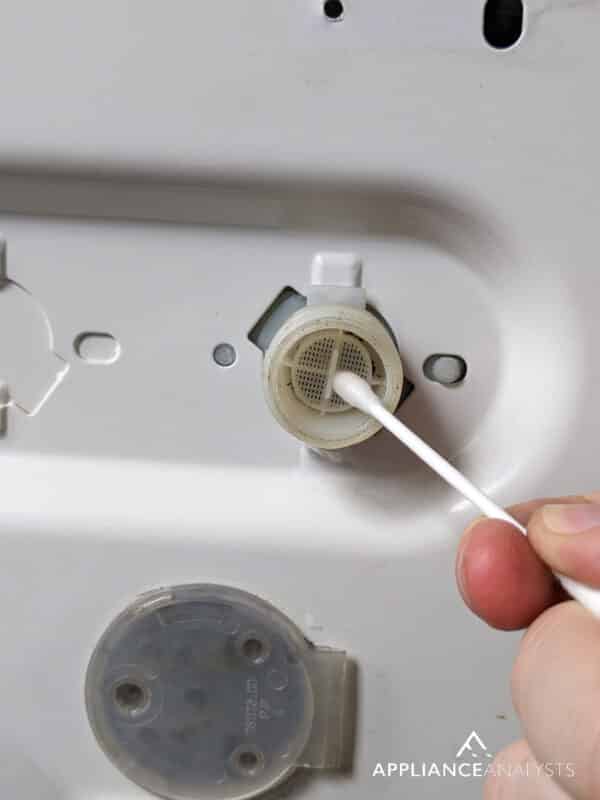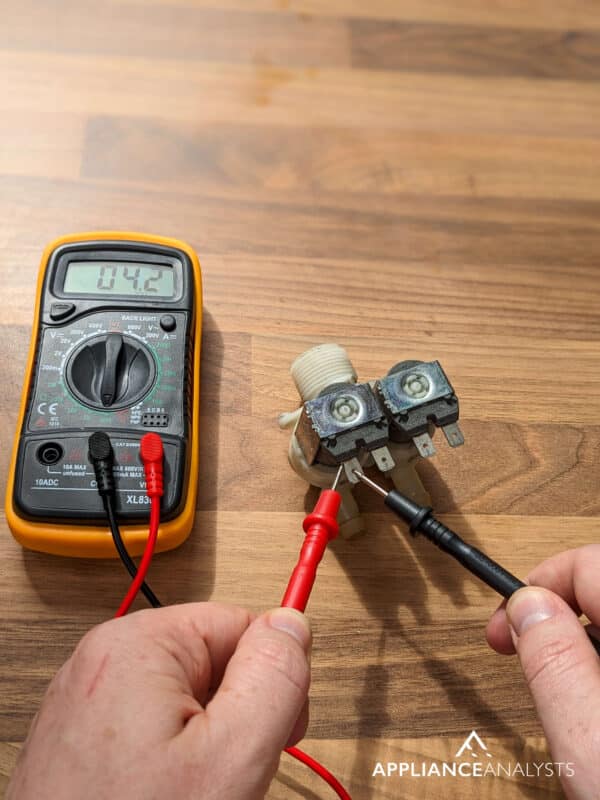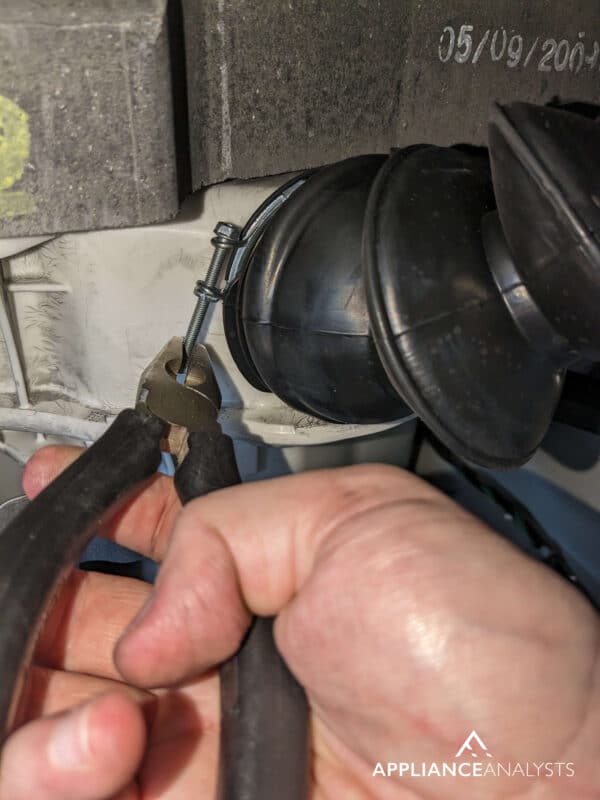We've independently reviewed this article to make sure it's as accurate as we can make it.
To find out more about our article creation and review process, check out our editorial guidelines.
Is your washer stuck on a rinse cycle?
I’ve been there too! I understand how frustrating it can be when your washing machine experiences performance issues, especially when you have a pile of dirty laundry waiting to be cleaned.
Luckily, you’ve come to the right place.
If your washer is stuck on a rinse cycle, you’ll need to check the cold water valve, drain pump, and suspension rods or dampers. Inspecting the door switch, speed sensor, and timer or control board is also important.
Keep reading to stop your washer’s rinse cycle!
Why trust us? This article was written by Craig Anderson and James Blackford.
Craig has helped thousands of other homeowners repair their appliances since 2016.
James is one of our resident appliance experts with over 16 years of experience. He currently works as a Master Technician for SquareTrade, and runs his own appliance repair business.
Why trust us? This article was written by Craig Anderson and James Blackford.
Craig has helped thousands of other homeowners repair their appliances since 2016.
James is one of our resident appliance experts with over 16 years of experience. He currently works as a Master Technician for SquareTrade, and runs his own appliance repair business.
6 Solutions for a Washer That Can’t Get Past the Rinse Cycle
Different reasons can explain why your washer is stuck on a rinse cycle. Don’t worry, though. In this section, I’ll walk you through six solutions you can try.
Please keep in mind that you’ll need to access and replace some of your washer’s internal components to solve the issue. So, having the product’s model number and owner’s manual handy is important.
Can’t find your manual? No problem! Just click the link below to learn how to find any product’s manual online.
#1 Examine the Cold Water Valve
I find that when a washer gets stuck on the rinse cycle, it’s typically due to an issue with the cold water valve.
Washing machines rely on both hot and cold water throughout their cycles. However, cold water is specifically used during the rinse cycle to remove detergent residue effectively.
So, if there’s a problem with the cold water valve, your washer won’t receive the necessary amount of cold water for rinsing, causing it to get stuck. To check if your washer’s cold water valve is clogged, follow these steps:
- Unplug your washing machine from its power source or turn it off at the circuit breaker.
- Please turn off the water supply and disconnect the cold water hose, which is located at the back of the washer (it’s typically labeled or colored blue). Placing a bucket or towels on the floor to catch any water spills is a good idea.
- While you’re at it, please inspect the cold water hose for any visible signs of damage. If it’s bent or broken, it will need to be replaced.
- Look inside the valve where the hose is connected. If the screen has mineral buildup or debris, use a toothbrush (or a cotton swab) and vinegar to clean it gently. However, if the screen is heavily clogged, it’s best to replace it.

Once you’ve checked the cold water valve, reattach the hoses and plug your washer back into the power outlet. Then, run a rinse cycle to see if the issue is solved.
Note: If you find that the water pressure is weak, I recommend calling a plumber, as there’s probably an issue with your home’s water pressure or that specific line.
If the hose, screen, and water supply seem fine, you’ll need to test the water inlet valve with a multimeter. Here’s how to do it:
- Unplug your washer from the power outlet or turn it off at the circuit breaker to prevent electrical hazards.
- Access the water valve, usually located at the back of the washer. Refer to the owner’s manual for detailed instructions on how to access it.
- Set your multimeter to the ohms or resistance setting and place one probe on one terminal of the cold water solenoid and the other probe on the other terminal.
- If the reading indicates zero resistance, then you’ll need to replace the water valve.

However, if the water valve is not the issue, then you’ll need to check other components. Read on to learn more.
#2 Check for Drainage Issues
In my experience, drainage issues can also explain why your washer is stuck on a rinse cycle.
After rinsing, your washer needs to drain the used water before proceeding to the next cycle. Unfortunately, if your machine can’t drain water properly, it will become stuck on the rinse cycle.
Follow these instructions to fix your washer’s drainage issues:
- Inspect the drain hose. Use a long brush to remove any debris or obstructions that could keep your washer from draining water. While you’re at it, check for any signs of damage. If the drain hose is kinked or broken, please order a replacement.
- Check the drain pump filter. If you have a front-load washer, please clean the pump filter, which is usually found at the bottom of the unit. Rinse the filter under running water to remove any debris causing blockages. If necessary, use an old toothbrush.
- Examine the drain pump. If it’s blocked, please unclog it. However, if you notice any signs of damage, please replace it with a new, compatible one.

#3 Inspect the Suspension Rods or Dampers
If your washer is still stuck on the rinse cycle, it’s time for us to inspect the suspension rods or dampers.
The suspension components are responsible for maintaining the stability and balance of the drum.
Once the rinse cycle has finished, your washer will spin. However, if the machine detects an imbalance due to issues with the suspension rods or dampers, it will refuse to spin and get stuck on the rinse cycle.

If your washer’s suspension rods or dampers are faulty, you’ll notice excessive shaking, a loud banging noise, or an “off-balance” error code.
Consider accessing the suspension components and checking for any visible signs of wear or damage. If necessary, get a replacement.
Remember that it’s best to call a professional if you’re uncomfortable testing or replacing the suspension rods and dampers yourself.
#4 Test the Door Switch
When fixing a washer that is stuck on the rinse cycle, I usually advise checking the door or lid switch.
The door switch is a safety mechanism that prevents the washer from running when the door is open. Sometimes, when the door switch malfunctions during a cycle, it sends a signal to the control board, mistakenly indicating that the door has been opened. As a result, the washer will stop during the rinse cycle and won’t spin.
To rule out the door switch as our possible culprit, test it with a multimeter. Here’s how to do it:
- Unplug your washer from its power source and access the door switch. Remember that the door switch’s exact location will vary depending on your washer’s model, so please refer to the owner’s manual.
- Carefully disconnect the wires connected to the door switch.
- Set your multimeter to the continuity setting and place one probe on one terminal of the door switch and the other probe on the opposite terminal.
- If your multimeter doesn’t beep or display infinite resistance, you’ll need to replace the door switch. You should also compare the resistance readings displayed with the manufacturer’s recommended values.

#5 Check the Speed Sensor
From what I’ve seen, a faulty speed sensor can also affect your washer’s rinse cycle.
The speed sensor, also known as the hall sensor, measures the motor’s speed to help the control board determine which cycle the washer should be in. If the speed sensor malfunctions, the washer will get confused about its current cycle, which can cause it to become stuck during the rinsing stage.
Keep in mind that not all front-load washers come equipped with a speed sensor. So, please refer to the manufacturer’s manual to determine whether your washer has one.
You can visually inspect the speed sensor, which is usually located next to the stator. If you notice any signs of wear or damage, you must replace it with a new one.
It’s worth mentioning that accessing and replacing the speed sensor can be a bit challenging. So, if you’re not an experienced DIYer, it’s a good idea to call an appliance repair expert.
#6 Inspect the Timer or Control Board
If you’ve tried all the fixes mentioned in this article and your washing machine is still stuck on the rinse cycle, it’s time to look into the timer or control board.
Older washing machines use a timer that switches between different stages. On the other hand, modern washers have a control board that reads signals from sensors and controls various components to move to the next cycle.
Unfortunately, issues with the timer or control board can cause your washing machine to get stuck on one cycle.

If the timer or control board is faulty, the most practical solution is to replace it. However, you should first consult your warranty status and consider the age of your washer. Diagnosing and repairing control boards and timers can be quite complex and expensive.
So, if your washing machine is over 13 years old and experiencing other performance issues, replacing it is often more cost-effective. However, if you’ve recently purchased your washer, it’s probably still under warranty. In such cases, the manufacturer will likely replace the faulty component for free.
Wrapping Up: Fixes for a Washer Stuck on a Rinse Cycle
That about covers it! Hopefully, you now know how to prevent your washer from getting stuck on the rinse cycle.
Remember that you’ll need to examine the cold water valve and clear any blockages. It’s also important to check the drain hose, test the door switch, and examine the suspension rods or dampers.
Don’t forget that checking the speed sensor and timer or control board can also help you solve the problem.
Thank you so much for taking the time to read this article. If you ever experience a different issue while using your washing machine, please check out our related posts below.
Good luck!









